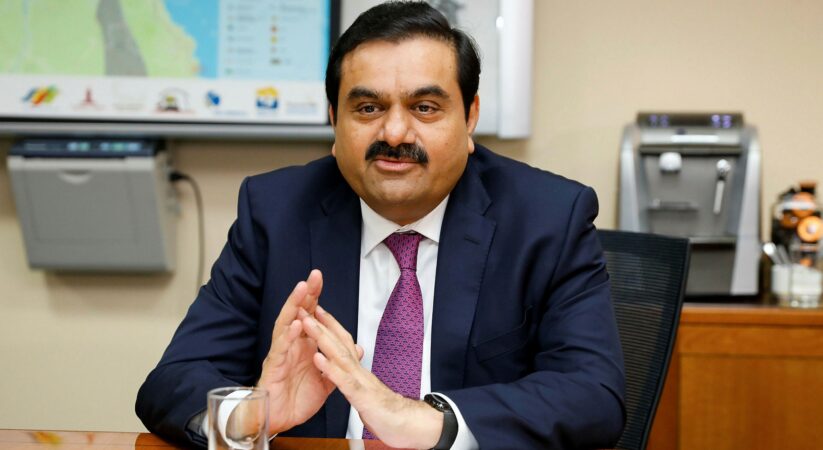After a U.S. short seller cast doubt on Gautam Adani’s business practices and hammered shares in his companies as well as his reputation, the Indian billionaire, who dropped out of school to become Asia’s richest man, faces possibly the biggest challenge of his career.
Adani, whose home state is Gujarat in western India, started out as a commodities trader and built his business empire from the ground up. Since Narendra Modi, the Prime Minister of India, is from the same state, their relationship has been closely scrutinized by Modi’s adversaries for years.
Adani’s wealth increased exponentially as his business empire expanded. Ports, power generation, airports, mining, edible oils, renewable power, and, more recently, media and cement are among his areas of interest.
With a net worth of $127 billion, he became the third richest person in the world, behind only Elon Musk and Bernard Arnault, according to Forbes. He has two sons, Karan and Jeet, who are both involved in the company’s operations. He is married to dentist Priti Adani.
In a nation where many billionaires inherit their wealth, the 60-year-old, who comes from a middle-class textile family, was far less well-known than other billionaires.
One person with direct knowledge of his dealings said that his business style was “very hands-on.”
In the last three years, amid aggressive expansion, Adani’s seven listed companies saw their stock prices soar, sometimes by more than 1,500%. He refuted claims made by Modi’s adversaries that he had benefited from their close relationship.
When Reuters asked Adani in a 2014 interview if he was friends with Modi, he responded that he had friends from all political parties but avoided politics.
When asked about Modi’s use of Adani corporate planes during the interview, Adani stated that Modi “pays fully.” He has stated that no political leader is to blame for his success.
The $220 billion Adani Group empire has attracted foreign investment in recent years. For instance, TotalEnergies (TTEF.PA) of France collaborated with Adani last year to create the largest green hydrogen ecosystem in the world.
Adani has recently engaged in proactive public image building by giving interviews to local and international media.
In a popular Hindi television show this month called the “People’s Court,” Adani answered questions about his conglomerate in a fake witness box set up inside a courtroom. This provided an unusual amount of scrutiny. He said that he is “a shy person” and that the political attacks he has had to deal with have played a role in his rise to popularity.
The government of Modi has refuted claims that it favors Adani.
During the show, Adani said, “People got to know who Adani (was) because of constant targeting by Rahul ji during the 2014 elections and after that,” referring to Rahul Gandhi, the leader of the opposition Congress party.
His group’s listed companies’ shares plunged on Friday three weeks later, bringing their week-to-date losses to $48 billion. Hindenburg Research, a short seller, raised concerns about Adani’s high debt on Wednesday and said that Adani’s businesses had improperly used offshore tax havens. Adani has stated that he is contemplating taking action and called the report baseless.
CHALLENGE TO REPUTATION
On its website, Adani Group states that its mission is to create assets of national significance and transform lives through self-reliance and sustainability while maintaining a balance between “growth with goodness.”
Adani has a history of controversy. The most recent was a lawsuit he filed against the state government and fishermen’s leaders following months of fishermen’s protests against the construction of a $900 million port in Kerala, southern India. In addition, for a number of years, environmental activists in Australia opposed Adani’s Carmichael coal mine project in Queensland on the grounds that it would harm the Great Barrier Reef and emit carbon dioxide.
The group’s flagship company, Adani Enterprises (ADEL.NS), launched the country’s largest public secondary share offering this week with the goal of raising $2.5 billion. His latest challenge is how to deal with an unprecedented share price rout.
On Friday, the stock fell significantly below the offer price, casting doubt on its success.
Dilip Cherian, an authority on image, stated to Reuters that the Hindenburg Report and its aftermath could pose a threat to Adani’s reputation, but he could mitigate that risk, reassuring investors of the group’s financial and asset strength, and ensuring the success of the share sale.
Cherian stated, “In terms of the kind of stellar rise he has had this is a hazard.”
In December, Adani stated without specifying who he was referring to that those posing questions about the group’s debt had not thoroughly investigated its financials.
Adani was seen heading to a meeting at the New Delhi office of the federal power minister as the market collapsed on Mumbai exchanges. Adani Group did not respond to a request for comment on Friday, so it is unknown what was discussed.
According to Jefferies, Adani Group’s consolidated gross debt is $23.34 billion. The Adani Group has repeatedly stated that its borrowings are manageable, and no investor has expressed any concern, despite Hindenburg’s assertion that key listed Adani companies have “substantial debt” that has placed the entire group on a “precarious financial footing.”
- Top 5 Health Insurance Stocks to Add to Your Portfolio - July 26, 2024
- 7 Reasons Edamame is Great for Your Health - July 26, 2024
- 2024 Paris Olympics: How Many US Athletes Are Competing? - July 26, 2024





